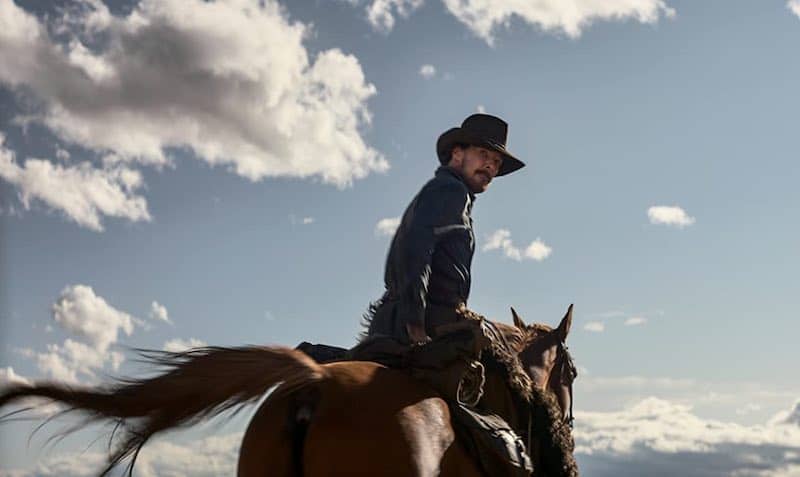The Power of the Dog, written and directed by Jane Campion, is assumed by many to be Benedict Cumberbatch’s film as he portrays a bullying, hypermasculine cowboy in 1925 Montana. Cumberbatch is terrific, I’ll admit that. But I think it’s Kodi Smit-McPhee’s film as Peter, the ‘Nancy Boy’ in the story. Hear me out.
The Power of the Dog opens with Peter, in voice-over, delivering these lines. “When my father passed, I wanted nothing more than my mother’s happiness. For what kind of a man would I be if I did not help my mother? If I did not save her?”

Peter and his mother Rose (Kirsten Dunst) own a small hotel/cafe near a railroad line. When Phil (Benedict Cumberbatch) and his crew of cowboys bring a herd there for transport, the cowboys sleep and eat at Rose’s place. Phil’s brother, George (Jesse Plemons), who rides his horse in a suit, tie, and bowler hat is there taking care of the finances.
Peter makes paper flowers to put on his father’s grave. He serves tables with a towel over his arm like a wine steward. Phil targets him with derision and scorn. He calls Peter a Nancy Boy. He makes Rose cry. The cowhands, who regard Phil with adoration, join in the bullying and teasing.

Later George returns to Rose’s. He marries Rose and brings her to the ranch. Peter is away in medical school.
Phil is no friendlier to Rose when she’s in his house that he was before. He torments her in many ways. She copes by drinking and staying away from him.
Phil was full of contradictions. He’d gone east to an Ivy League college where he studied the classics. He played the banjo very well. He loved to soak in the dirt and stink of ranch life. He called his brother “Fatso” but depended on him and wanted his approval. He displayed cowhides on his fence in plain sight and instructed his staff to tell the Shoshone people who came asking to trade for hides that there were none.
Rose caused a big scene when she ran after a Native American man and gave him all the hides in exchange for a beautiful pair of beaded soft leather gloves.

When school lets out for the summer, Peter joins them at the ranch. He brings a row of medical books, a set of surgical tools, and some rubber gloves. He uses these tools to practice dissection on whatever creatures he can grab, such as helpless bunnies.
Phil worships the man who taught him to ride. He speaks of the dead Bronco Henry with love. He still soaps the dead man’s saddle with sensuous strokes. He has a hidden lair by the river where he swims naked and where he hides magazines with photos of naked men.
Peter, of course, understands Phil’s secret. He finds Phil’s hidden spot. He befriends Phil who changes to regard himself as Peter’s mentor. He takes Peter out on rides, teaches him things about ranching – such as to stay away from any animal that died of anthrax. Phil begins braiding a rawhide rope for Peter.
George is often gone on business and Rose is more and more miserable and depressed inside the ranch house. She’s often in bed most of the day. As the tension builds in this dysfunctional situation, Peter sees a solution.
The progress of the storytelling was brilliant. Only when the end came with its surprise did we recognize the strange dissonances we’d felt along the way as clues Campion left. It was suspenseful and masterfully done.
Jane Campion is a director whose work I never miss. I thought The Power of the Dog was exceptionally good, even for her.
Filmed in New Zealand, not Montana, this is absolutely one of the most beautiful films I’ve ever seen. Campion and cinematographer Ari Wegner make every frame of the over two hour long film a work of art. It’s breathtaking and perfect.
The Power of the Dog is available on Netflix and is definitely a must see film for 2021.

just watched – I liked it – dialog was a bit slow at times but it was suspenseful – you know something is going to happen but don’t know what or when – I agree Kodi Smit-McPhee gave his character some depth – Kirsten Dunst and Jesse Plemons are married in real life – they met on Fargo set – Benedict Cumberbatch is not a favorite of mine – but he did justice to being creepy – not a film for everyone – husband left 1/2 way through
The unspoken, drawn out tension of it made it work. But it isn’t an action movie with a lot going on. I can see why he might have given up on it half way through.
I loved every stroke, every niance of this movie. I am a huge fan of Jane Campion and, for me, she has outdone herself with The Power of the Dog. Kodi Smit- McPhee owned every bit of his character as did Benedict Cumberbatch but I think this is Smit-McPhee’s film.
It was SO nuanced. Just some of the expressions on Kirsten Dunst’s face were a whole treatise on nuance.
I enjoyed Top of the Lake so I was looking forward to this. It is definitely a welcome surprise in character study for sure. Brilliant pictures and scenes. Quite suspenseful but also slow at times. I agree that it is Smit-McPhee’s movie. My favorite scene was with the hula hoop. I also loved the “Radetzky March” scene. A friend has challenged that we rewatch it a take a drink every time we here the name Bronco Henry.
I’ve been planning to watch it again, too. That drinking challenge might knock me out before the film was over.